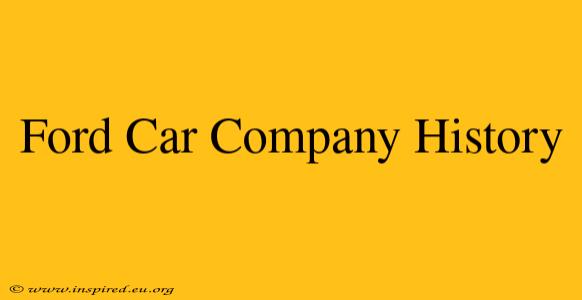The Ford Motor Company, a name synonymous with American ingenuity and automotive history, boasts a legacy spanning over a century. From its humble beginnings in a Detroit shed to its current position as a global automotive giant, Ford's journey is one of innovation, resilience, and adaptation. This article delves into the key moments that shaped the Ford Motor Company into the iconic brand we know today.
The Early Years: Innovation and the Assembly Line
Henry Ford's Vision: In 1903, Henry Ford founded the Ford Motor Company, driven by a vision of affordable automobiles for the masses. His early models, like the Model A and Model B, laid the groundwork for future success, but it was the Model T that truly revolutionized the industry.
The Model T and the Assembly Line: The Model T, introduced in 1908, became a cultural phenomenon. Its affordability, durability, and ease of maintenance made it accessible to a wider population than ever before. Even more impactful was Ford's revolutionary assembly line process. This system dramatically reduced production time and costs, making cars cheaper and faster to produce. This innovation not only transformed the automotive industry but also influenced manufacturing processes across numerous sectors.
The Rise to Dominance: Expanding Market Share
Ford's dominance in the early 20th century was undeniable. The Model T's popularity propelled the company to the forefront of the automotive world, making it a household name. The company's vertical integration strategy, controlling various aspects of production from raw materials to distribution, further solidified its position. Ford's impact extended beyond the economic sphere; its cars became symbols of American progress and prosperity.
Mid-20th Century: Adapting to Change
Beyond the Model T: While the Model T was immensely successful, the market eventually demanded more variety. Ford introduced the Model A in 1927, marking a departure from the Model T's simplistic design. This model, with its updated styling and features, signaled Ford's willingness to adapt to changing consumer preferences. The subsequent decades saw the introduction of iconic models such as the Ford V8, a powerful engine that established a new standard for performance.
Post-War Boom and Diversification
The post-World War II era witnessed a surge in demand for automobiles. Ford capitalized on this boom, producing a range of popular vehicles that catered to diverse needs. Beyond cars, Ford diversified its product line, expanding into trucks, tractors, and other industrial vehicles. This diversification proved crucial in navigating economic fluctuations and maintaining market competitiveness.
The Late 20th and Early 21st Centuries: Challenges and Transformations
Globalization and Competition: The latter half of the 20th century brought increased global competition. Japanese automakers, with their focus on fuel efficiency and quality, posed a significant challenge to Ford's dominance. The company responded by investing in new technologies and improving its manufacturing processes.
Restructuring and Innovation: Ford faced financial difficulties in the early 21st century. Restructuring efforts, coupled with a renewed focus on innovation, were essential for its survival. The company's investment in fuel-efficient vehicles and the development of new technologies, such as hybrid and electric vehicles, demonstrate its commitment to adapting to the changing automotive landscape.
Ford Today: A Modern Automotive Leader
Today, Ford remains a leading global automaker. It continues to innovate, developing advanced technologies like autonomous driving systems and electric vehicles. The company's commitment to sustainability and its ongoing efforts to improve its manufacturing processes reflect its enduring legacy of innovation. From its humble beginnings to its current position as a major player in the global automotive market, Ford's story remains a testament to the power of vision, resilience, and adaptation in a dynamic and ever-evolving industry.
Frequently Asked Questions (FAQ)
Q: When was the Ford Motor Company founded?
A: The Ford Motor Company was founded in 1903.
Q: What was Ford's most famous car?
A: The Ford Model T is arguably Ford's most famous car. Its revolutionary impact on manufacturing and affordability is still felt today.
Q: What innovations did Ford pioneer?
A: Ford pioneered the moving assembly line, dramatically changing manufacturing efficiency. They also introduced iconic engines like the Ford V8.
Q: What challenges has Ford faced throughout its history?
A: Ford has faced numerous challenges, including increased global competition, economic downturns, and the need to adapt to changing consumer preferences and environmental regulations.
Q: What is Ford's current focus?
A: Ford is currently focused on developing electric vehicles, autonomous driving technology, and other advanced automotive technologies. Sustainability is a key part of its current strategy.
